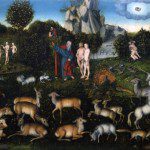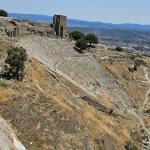Yesterday I posted the first part of my interview with Frank Viola about his new book, coauthored with Leonard Sweet, called Jesus: A Theography. Frank blogs for Patheos, and the book has received a strongly positive response. Interested readers can get a free copy of Frank’s next book by going here, and they can learn more about Jesus: A Theography here.
*
 The life of Jesus, as you say, encompasses not only those 33 years or so of his earthly life and ministry but all of time and space, and indeed stands even outside time and space. So Genesis 1 and 2, whatever else they might say regarding the creation, tell us something about God’s Logos and God’s redemptive plan. Tell us a bit of what you have to say on Genesis 1 and 2?
The life of Jesus, as you say, encompasses not only those 33 years or so of his earthly life and ministry but all of time and space, and indeed stands even outside time and space. So Genesis 1 and 2, whatever else they might say regarding the creation, tell us something about God’s Logos and God’s redemptive plan. Tell us a bit of what you have to say on Genesis 1 and 2?
We dedicate two long chapters to unearthing the shadows contained in Genesis 1 and 2 and their fulfillment in Christ. Here’s a very brief snapshot of some of the points we unravel and expound in the book:
- Genesis 1 opens the same way that John 1 does. “In the beginning . . . “ This is no accident.
- The two chapters also use the same language. In Genesis 1, it’s “the first day . . . “the second day . . .”, etc. In John 1, it’s “on the next day . . . and the next day . . ., etc.”
- On the first day in Genesis 1 we have Light being called forth out of darkness. In John 1, Jesus is said to be “the Light that shines in the darkness.” John is the new Genesis. We demonstrate in our book that John is telling the story of the new creation. Paul alluded to Christ being the Light on the first day also when he wrote in 2 Corinthians, “God who commanded light to shine out of darkness . . . has shone in our hearts to give the light of the knowledge of the glory of God in the face of Jesus Christ.”
- On the third day of creation, we have the first appearance of life. It is life that emerges out of the sea. Jesus Christ, the Life, arises out of death on the third day. All throughout the Bible, “the third day” represents resurrection. The NT writers say that Jesus would rise again from the dead on the third day “according to the Scriptures.” They were referring to these references to the third day, which begins in Genesis 1.
- The seventh day, of course, is the Sabbath. But in Colossians 2, Paul tells us that the reality of the Sabbath is Christ Himself, our true Rest. The writer of Hebrews alludes to the same thing in Hebrews 4. In our book, we show how each day of creation points to Christ and we give the corresponding references in the NT.
- In Genesis 2, we have a gripping scene. God says that it’s not good for Adam to be alone. So puts the first man into a deep sleep. And out of Adam’s side, He brings forth a woman . . . a bride. She, who was once in Adam’s side, now becomes one with him. In John, God puts His Son into the deepest sleep of all . . . the sleep of death. And when Jesus is dead, His side is opened and from it pours water and blood. Then, at His resurrection, Jesus becomes a “life giving Spirit” and imparts His life into His disciples. And they – collectively — are later called the body of Christ and the bride of Christ. In Ephesians 5, Paul tells us that the Genesis story is a “great mystery.” Because it doesn’t just speak of the first man and the first woman. It speaks of Christ and the church. Paul says in 1 Corinthians 15 that Jesus is the “second Man” and the “last Adam.” In Romans 5, Paul says that Adam prefigures Jesus. The church was “in Christ before the foundation of the world” just as Eve was in Adam before she emerged. Water in the NT represents the cleansing of God’s Word and blood represents redemption and forgiveness. So Christ’s death, the appearance of the Bride of Christ (which is “one body” with Jesus), redemption and cleansing are all prefigured in Genesis 2.
- In addition, in John 12, Jesus said that if a grain of wheat falls into ground alone, it will die (God said it’s not good for man to be alone). But if the grain of wheat dies, it will be “fruitful and multiply” and bear many grains like unto itself. Jesus is the reality of the one grain who died and who has, in His resurrection, brought forth many grains like unto Himself. This principle is also prefigured in Genesis 1 and 2.
- Finally, if you read the first two chapters of Genesis and the last two chapters of Revelation, you’ll be fascinated to find that there are over 30 parallels between each chapter. The NT shows us that all of these parallels . . . the tree of life, the flowing river, the garden, gold, pearl, and precious stone, the command to “eat freely” (Genesis) and “drink freely” (Revelation), the city, the marriage, the bride, the bridegroom, all point to Jesus Christ and God’s eternal purpose in Him. I’m just scratching the surface in these examples as there’s so much more to it, and we cover those things in the book.
Christ’s story and the story of this world overlap, yet the story of this world is only a part of the Son’s story. So what is the final chapter in the story of this present world and what role does Christ play in it?
We begin the book before time (where the Son’s story begins) and we conclude the book when time ends (where the Son’s story is consummated). Thus we explore and revisit the second coming of Christ and the whole matter of eschatology. NT scholar Craig Keener read the entire manuscript before we published it and made the remark that the chapter on the second coming was his favorite. We take dead aim at a few popular theories on the return of Jesus and put them to rest in a way that’s subtle yet effective.
In short, the “end of time” will look very similar to “before time.” In the beginning, God was All. In the end, He will be All in All. And Christ will fill all things, as Paul says in Ephesians. The two bookends of the Bible – Genesis 1 & 2 and Revelation 21 & 22 – tell the breathtaking story. We unravel the themes in those four chapters and trace them throughout the OT and NT. This makes for an epic saga of God’s ultimate intention to get us back to the Garden and fulfill the timeless purpose for which we were created. It is what Paul calls “the eternal purpose,” which is the grand narrative of the entire Bible. And I’ve treated that in detail in another volume called From Eternity to Here.










